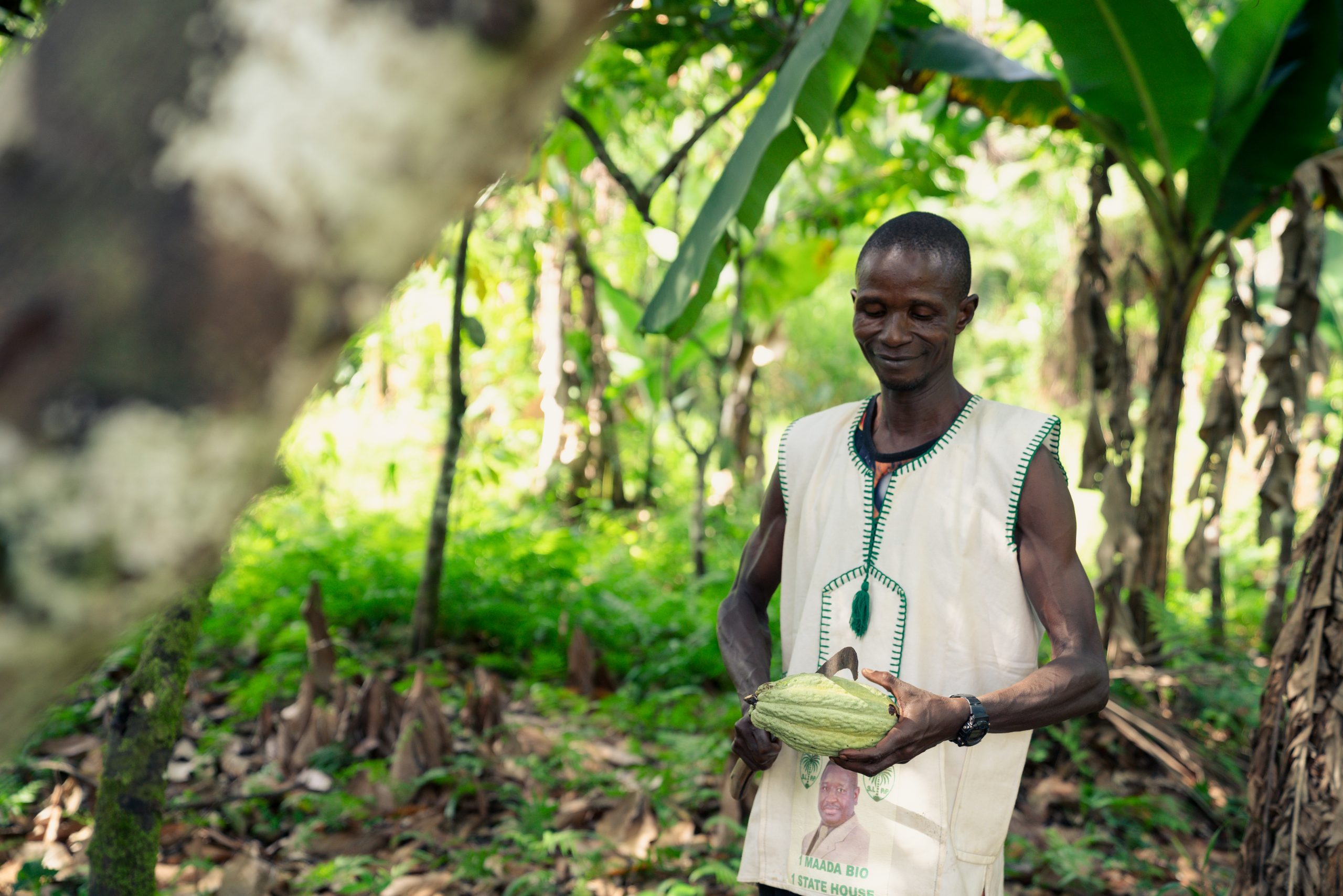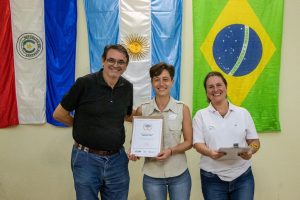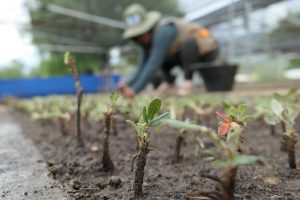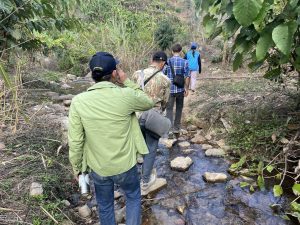In the Gola Rainforest in Sierra Leone, Trillion Trees partner BirdLife International, operating through the Conservation Society of Sierra Leone and the RSPB, are working with the local forest-edge communities to help save precious tropical forest through the power of sustainable cocoa.
Thousands of cocoa farmers, specifically indigenous Ngoleagorbu people, have grown cocoa in this region for generations, but previously earned little benefit: they might have received as little as 3% of the value of the chocolate produced from their cocoa. This project aims to turn that around by investing in forest-friendly, shade-grown cocoa that brings improved long-term returns for local people – and nature.
The cocoa farmers have joined together to form cooperatives founded on democratic principles. Farmers register, pay subscription fees and elect leaders to manage the business. The project supports them with training, equipment and technical advice. From their forest-edge smallholdings, the farmers take their harvested cocoa to local processing sites, then on to a buying centre. Each centre is equipped with scales, a receipt book and a published price per kilo of cocoa – a level of transparency not previously seen by the community.
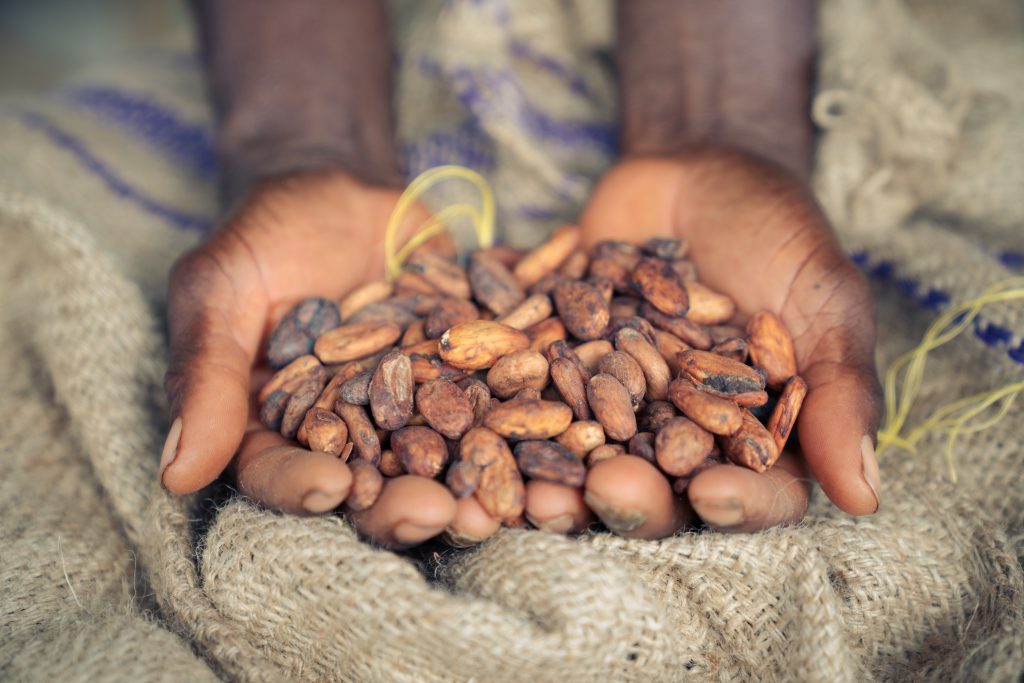
Mallo K. Sama is a cocoa farmer from Gorahun in the Tunkia chiefdom and a member of the Tunkia and Koya Cocoa Farmers Cooperative (TUNKOCFCO). He is also chairman of the Tunkia Gola Community Development Committee (GCDC) – a term that lasts for two years. The GCDC helps to support communities with development projects such as the construction of a community hall or water pump with funding from the Gola Rainforest community development programme.
Mallo is proud of his family’s cocoa farming heritage, owning cocoa trees that are around 35 years old. The Gola Rainforest Conservation company (GRC) trains the farmers in the cooperative in improved cocoa farming techniques that will enhance the quality of the cocoa and increase profits for the farmers who are able to sell their produce at premium prices to higher value markets around the world. These trainings also promote the importance of conserving the environment and maintaining healthy community forests alongside cocoa farms.
The selling cycle has been transformed through GRC’s approach – Mallo sells his cocoa to the TUNKOCFCO for a good price; GRC exports it and gives the profit back to the cooperative. Through the increased profits from his cocoa trees, Mallo has been able to support his children through school and feed his growing family. One of his daughters now attends a private secondary school and has taken her West African Senior School Certificate Examination.
He says, “I’ve benefited from the training from Gola Rainforest. Now, I know how to ferment cocoa, I know how to plant cocoa and how to produce it. I use the profits I make to pay for food and for my children’s schooling.”
Shiaka Boa is the Buying Officer for Tunkia and Koya Cocoa Farmers Cooperative and a farmer. He comes from Njagboima, a village in the chiefdom where his farm is based.
As the Buying Officer, he buys cocoa from farmers in the different villages across the chiefdom: Njagboima, Matakan, and Jopowahun.
There are various roles within the Farmers’ Cooperatives. The Secretary records all the farmers’ names; the Buying Officer weighs and records the cocoa and gives the farmers a receipt; the Master Farmer teaches others how to prune the cocoa plants, how to ‘brush’ their farms to remove weeds and bushy undergrowth, and the best time to do so. The Chairman organises the meeting every month.
Shiaka says: “Every farmer in this village is a member of the cooperative. They want to be members because they see the benefits and get a good price for their cocoa.
“The training provided by Gola Rainforest involves learning how to ferment cocoa; how to prune the cocoa plants properly, how to brush them, how to look after the plants in the nursery and the importance of having a ‘buffer zone’ around cocoa farms to conserve important habitats."
The farmers’ training also includes agroforestry techniques whereby cocoa trees are strategically planted alongside leafy shade trees which birds love, nitrogen-fixing trees for soil fertility, and other produce like pineapple, palm tree, yam and bananas that can be sold for profit or eaten.
Shiaka has learned a great deal from the farmers in the cooperative and has even taught some of them himself. His farm is producing much more cocoa because of the techniques he has learned, and other farmers are following suit.
He adds: “Now that Gola Forest has implemented agroforestry, many of the farmers’ gardens are full of produce like pineapple and banana, so they no longer need to buy food from other places and can also sell the produce.”
“I am young, but I have big responsibilities. We have children, and I look after my mother. The money we get, we spend to assist my mother and my family. After the war, we lost everything. The houses were broken; so we use the money from the cocoa farming to repair the houses.”
Shiaka is grateful for the help that Gola Rainforest has provided for the cocoa business. There is much more to do, but they wouldn’t have been able to get where they are without the support and the training. He is hopeful for the future.
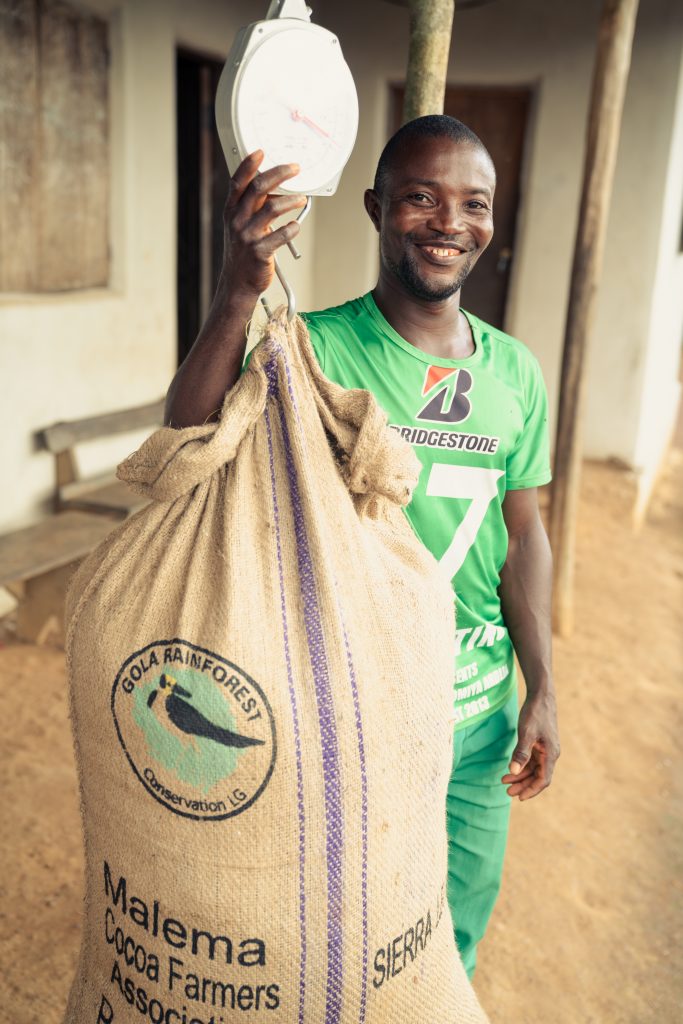
Gola forest-friendly cocoa is in the process of becoming fully organic-certified. It is sold to international buyers and chocolate makers to be used in popular products such as chocolate bars and ice cream. The aim is to export 200 metric tons of Gola cocoa to premium markets annually. The income generated is divided between supporting the farming community and reinvesting into the forest friendly cocoa business.
Around 40,000 people in over 120 forest-edge communities are being supported and empowered by the project, and cocoa farmers are seeing more than 50% increase in income. From the project’s interventions, education, health and gender equality metrics are all improving.

